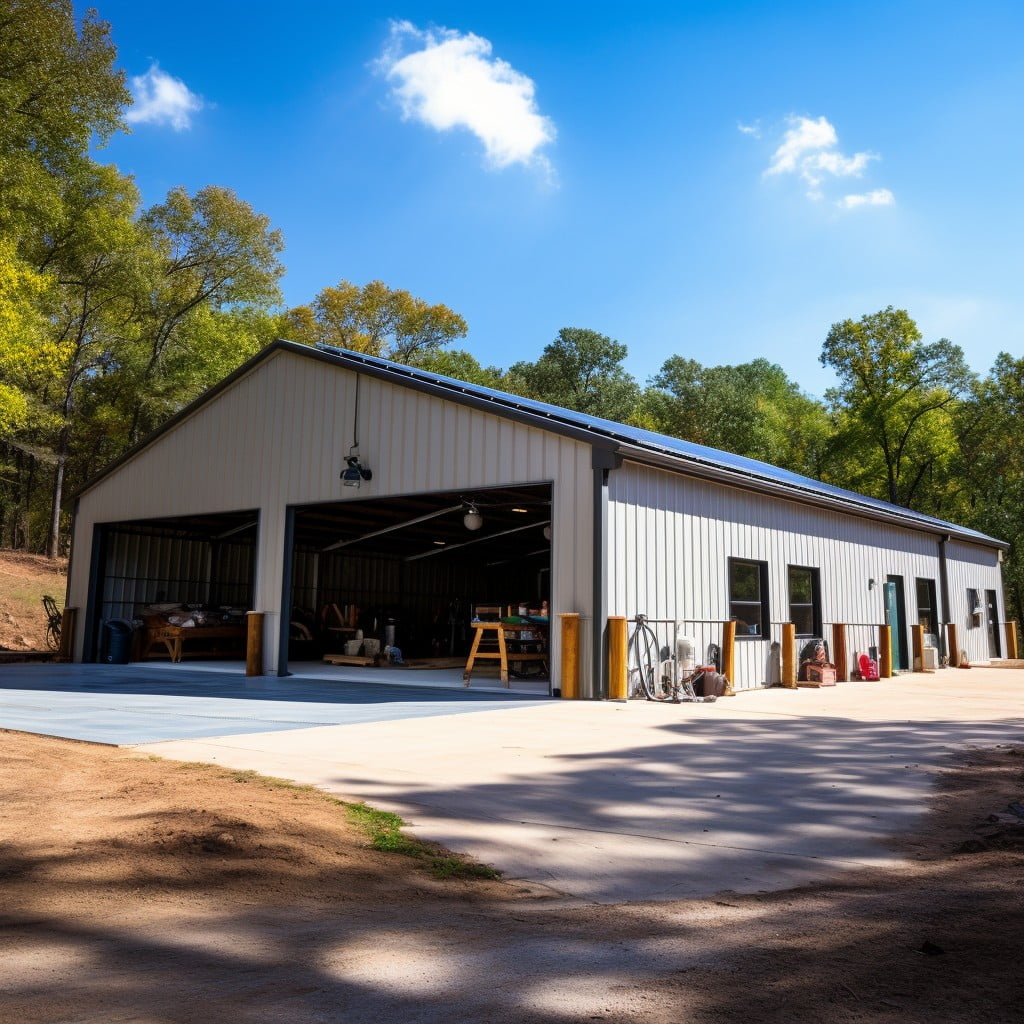Discover the essential steps to effectively ground a metal building, ensuring safety and stability for years to come.
Grounding a metal building is a crucial step in the construction process, ensuring the safety of the structure and its occupants. This process involves connecting the metal parts of the building to the earth to prevent electrical shocks or fires.
This article will guide you through the necessary steps to ground your metal building correctly, covering all the essential details such as the materials required, the legal requirements, and the actual process of grounding. By following these guidelines, you can ensure that your metal building is safe, secure, and grounded to industry standards.
Key takeaways:
- Ensures Safety: Reduces electrical shock hazards and protects appliances.
- Prevents Electrical Overloads: Safeguards against short circuits and surges.
- Enhances Equipment Lifespan: Reduces power surges and extends device longevity.
- Complies with Building Codes: Meets local regulations and improves safety.
- Follow Proper Aftercare: Regular inspections, clean connections, and soil resistivity measurement.
Importance of Grounding a Metal Building

Grounding serves a vital role in safeguarding a metal structure, along with individuals and assets contained within it. By creating an efficient path for electrical energy to follow, grounding helps to dissipate potentially dangerous electrical charges to the earth.
Here are some significant points to consider:
- Ensures Safety: Grounding aids in reducing the risk of electrical shock hazards to occupants and helps prevent damage to appliances inside.
- Prevents Electrical Overloads: Grounding serves as a preventive measure against electrical overloads. When a short or an electrical surge occurs, the grounding wire provides a path for the excess electricity, thereby protecting the circuit.
- Enhances Equipment Lifespan: Grounding can extend the longevity of devices within the building by reducing the level of power surges that they experience.
- Complies with Building Codes: Grounding your metal building also ensures compliance with local building codes and regulations.
Basic Concepts Involved in Grounding

Grounding, from a scientific standpoint, is designed to protect people and control the built-up of electrical energy. At its core, grounding creates a direct physical connection between the metal structure and the earth. The following points will explain these concepts more elaborately:
- 1. Electricity follows the path of least resistance. Your grounding process provides a path specifically designed to handle electrical charges, ensuring they return safely to the ground.
- 2. Grounding prevents electric shock. With a grounding system in place, stray electrical energy that could cause harm gets redirected safely into the ground.
- 3. Lightning protection is another benefit of grounding. Metal buildings attract lightning, and good grounding can prevent the significant damage that a lightning strike can inflict.
- 4. Grounding also helps to regulate power surges. It stabilizes voltage levels and reduces the risk of damage to your building and any electrical equipment inside.
- 5. The importance of building codes cannot be ignored. Most regions have strict codes requiring metal buildings to be grounded to improve safety and reduce potential harm to people and property.
Procedures for Grounding a Metal Building

Start by driving a copper grounding rod, at least 8 feet in length, into the ground and as close to the building structure as possible. It’s advisable that at least 8 inches of the rod remains above the ground level. This rod serves as the primary grounding conductor.
The next step is to connect a copper wire, typically #6 gauge, from the base of the building structure to the grounded copper rod. Preferably, the wire should be attached using a process known as exothermic welding, as it ensures a stable connection. The goal is to create a direct path from the structure to the ground, facilitating the safe flow of electrical current in case of a power surge.
Afterwards, consider grounding the building’s steel components, if any, especially those that might be in contact with electricity. To do this, connect a grounding wire between the grounded copper rod and the steel component.
Finally, do not overlook the importance of grounding the electrical systems within the metal building. For electrical grounding, connect all metal boxes and conduit to the main electrical panel, which should also be rooted to the main copper grounding rod.
This is only a part of the process, be sure to follow all the guidelines established by the National Electrical Code (NEC). Remember, safety comes first in metal building grounding procedures.
Essential Materials for Grounding a Metal Building

To establish a safe ground for your metal building, certain specialized materials will be required. Traditionally, copper grounding rods, measuring up to 8 feet in length and about 5/8 inches in diameter, are crucial for this process. The extensive length ensures a robust and efficient grounding process.
Bare copper wire also plays a vital role. This wire, often 6 gauge, forms a direct pathway between the grounding rod and the metal building. It’s important to note, the wire must be solid and not braided or segmented.
Another critical component is clamps to secure the bare copper wire to the grounding rod. The clamps ensure that the wire stays fixed to the rod and maintains a steady connection.
Also, a grounding electrode conductor is required to connect the building’s electrical service panel to help disperse any electrical charge.
Finally, an anti-oxidation compound is also necessary. This compound, often a grease-like substance, is applied to the grounding connections to prevent the degrading effects of rust and oxidation over time.
Each of these components plays a unique role in ensuring a complete and effective grounding system for your metal building. They work together to protect the structure and its inhabitants from electrical faults or lightning strike damages.
Safety Measures to Employ During Grounding
Adherence to safety standards is paramount when grounding a metal building. First and foremost, ensure you’re using tools with insulated handles to prevent potential electric shocks.
Always remember to turn off all electrical equipment and circuits in the building before you start the grounding process. Gloves, safety glasses, and sturdy reliable footwear should be part of your outfit to avoid potential physical harm.
Proper training is crucial because grounding can be risky for unskilled individuals. Familiarize yourself with local safety regulations and building codes to avoid contravention.
Last but not least, foresee potential risks like adverse weather conditions – rain or high wind can complicate the process and increase the risk of accidents.
Proper Aftercare for Grounded Metal Buildings
Upon successfully grounding your metal building, it’s imperative that ongoing care is undertaken to maintain grounding efficacy.
1. Conduct Regular Inspections: Monthly or quarterly checks are recommended to verify the integrity of the grounding system. Check for loose connections, corrosion, and broken wires, which may disrupt the effectiveness of grounding.
2. Clean and Tighten Connections: Ensure all physical connections to your grounding electrodes are clean and tightly screwed or bolted. Oxidation and dirt can create resistance and hinder the grounding path.
3. Measure Soil Resistivity: The soil’s resistance plays a significant role in the efficacy of the grounding system. If the soil resistivity is high, consider adding a conductive material like bentonite around the ground electrode to reduce it.
4. Monitor Ground Resistance: This should be done yearly by measuring the electrical resistance of the grounding system with a resistivity meter.
5. Maintain Clearances: Keep the grounding area clear and easily accessible for inspections and potential repairs. Remove debris or vegetation which may cause damage or interfere with the grounding system.
Ensuring thorough aftercare of your grounding system is as crucial as the initial setup.
Maintenance Tips for a Grounded Metal Building
In maintaining the grounding of your metal building, regular checks and close attention to several key areas prove essential.
1. Inspection Allot time for routine monitoring of grounding systems. A keen eye ensures connections remain intact and functional. Properly document these checks to monitor performance efficiently.
2. Cleaning Remove any accumulated dirt or dust on grounding electrodes. They may affect the performance of the grounding system if left unchecked.
3. Assessment Consider hiring a certified professional for occasional reviews of the grounding system. Their specialized knowledge can spot potential issue before they become major problems.
4. Upgrading With industrial advancements, newer and more efficient grounding techniques may be available. Keeping the system updated can help the building maintain its resilience against electrical faults.
5. Repairs If there arises any indication of wear and tear, immediate repairs should be carried out to avoid any disruption in the grounding system.
6. Ground Resistance Measurements Maintain a regular check of the ground resistance levels. If these exceed allowed levels, immediate steps should be taken to lower them.
FAQ
Does my metal building need to be grounded?
Yes, every metal building must be independently grounded, with all its components electrically bonded together.
How do you ground a metal shed?
To ground a metal shed, an eight-foot copper alloy rod should be driven into the ground, and a number 8 gauge solid copper wire should be connected to both the copper rod and the metal shed.
What is the minimum depth for a ground rod?
The minimum depth for a ground rod is 8 feet.
What are the risks involved in not grounding a metal building?
Not grounding a metal building can lead to severe consequences such as electrocution risks, damages from lightning strikes, and susceptibility to power surges destroying electrical equipment.
Can a professional electrician be avoided while grounding a metal building?
No, the involvement of a professional electrician is essential for grounding a metal building, to ensure proper safety measures and electrical code compliance.
What materials are required for properly grounding a metal building?
Copper grounding rods, grounding conductors, clamps, and grounding plates are necessary materials for properly grounding a metal building.
Recap




